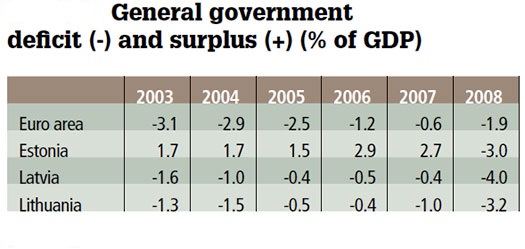
The New York Times columnist and Nobel Laureate Paul Krugman (“Dr. Gloom”) and New York University professor Nouriel Roubini (“Dr. Doom”), who gained fame as one of the first to detect the U.S. housing bubble, have fingered tiny Latvia as the next domino to fall. They argue that Latvia is in the same situation as Argentina was in late 2001. And as a result, Latvia will be forced to devalue its currency and default on its debt, as did Argentina in early 2002. Then, the argument goes, neighboring Estonia and Lithuania will be forced to follow suit and a damaging wave of devaluations and defaults will sweep through Central and Eastern Europe. This will be followed by yet more international gloom and doom.
Just what, if anything, does Latvia today have in common with Argentina in 2001? On the surface, it appears that Latvia is employing the same type of exchange-rate system as did Argentina. Latvia’s currency trades in a narrow band of plus or minus 1% around a peg of 0.7028 lats per euro. In 2001, the Argentine peso was linked to the U.S. dollar at one to one. But the similarities stop there.
Latvia and its Baltic neighbors have been models of fiscal prudence (see Tables 1 and 2). Before last year, when the recession began, all had low budget deficits or even budget surpluses. They have shown willingness to make tough cuts in government spending. They also have ratios of debt to GDP that remain quite low by international standards. Argentina, in contrast, had persistent problems with cutting spending and had a much higher debt to GDP ratio.


In the monetary sphere, there is a straightforward way to determine whether a monetary authority that links its currency to another is in danger of breaking the link: compare it to an “automatic” system. The most automatic system is a currency board, which issues money convertible on demand into a foreign anchor currency at a fixed rate of exchange. As reserves, a currency board holds foreign assets equal to 100% or slightly more of the monetary base (its note, coin, and deposit liabilities).
These characteristics ensure that the quantity of domestic currency in circulation is determined solely by market demand for domestic currency. They imply that for a currency board, net foreign reserves (foreign assets minus foreign liabilities) should be close to 100% of the monetary base. Moreover, “reserve pass-through” (the change in the monetary base divided by the change in net foreign reserves over the period in question) should also be close to 100%.
During the three years before Argentina’s currency crisis of December 2001-January 2002, Argentina’s monetary system, often mistakenly termed a currency board, was not operating in “automatic” fashion. Its reserve pass-through was not even close to 100%, and after mid 2001, its net foreign reserves as a percentage of its monetary base fell well below 100% (see Chart 1). By comparison, Latvia’s monetary system — even though not legally a currency board system — is operating largely as though it were one. In consequence, Latvia could convert its entire monetary base into euros at the current exchange rate. The same can be said of Estonia and Lithuania — two countries that officially adopted modified currency board systems in 1992 and 1994, respectively.
The data speak clearly. Latvia and its Baltic neighbors are not repeats of Argentina. Their economies have suffered greatly from a sudden stop of foreign investment and from recession in Western Europe, but they retain ample foreign reserves.
They would do better to officially adopt the euro, even without the blessing of the European Central Bank, than to devalue their national currencies.

Author Steve H. Hanke

0 responses on "Will Dr. Gloom and Dr. Doom’s Latvian Domino Fall?"